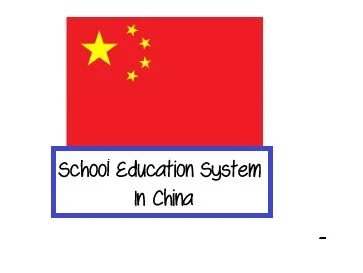China's
education system is known
for its rigor and emphasis on academic achievement. The system is structured
and centralized, with the Ministry of Education overseeing educational policies
and regulations at the national level. Here are some key aspects of China's
education system
Compulsory Education: Education is compulsory and free for
children aged 6 to 15, covering primary and junior secondary education.
The nine-year compulsory education aims to provide a basic foundation of knowledge
and skills.
Academic Pressure: China's education system places a strong emphasis on academic performance and standardized testing. Students face intense competition to achieve high scores in exams, as these scores determine their chances of entering prestigious universities.
College entrance examination: The National College Entrance Examination,
commonly known as the college entrance examination (Gaokao), is a highly
competitive exam that determines admission to higher education
institutions. It is taken by millions of students each year, and performance in
the college entrance examination is considered crucial for future
academic and career prospects.
Streaming and Tracking: The education system in China often
involves streaming and tracking students based on their academic performance.
This can lead to a division between students who are deemed academically strong
and those who are not. The students in the top tracks have better opportunities
for higher education.
Technical and Vocational
Education: In
recent years, China has been promoting technical and vocational
education to meet the demands of its growing economy. Vocational schools
provide practical skills training and prepare students for specific industries
or trades.
Education Reforms: China has been undertaking reforms
to address the shortcomings of its education system. The government aims to
reduce the emphasis on exams and promote a more holistic approach to education,
focusing on creativity, critical thinking, and practical skills.
International Education: China has also been investing in
international education and encouraging collaborations with foreign
institutions. Many Chinese students choose to study abroad for higher
education, particularly in Western countries.
Online Education: With the advancement of technology,
online education has gained popularity in China. Online platforms and
courses provide additional learning opportunities and flexibility for students,
especially in remote areas.
It's important to
note that China's education system is vast and diverse, with regional variations
in implementation and practices. While some aspects of the system have received
praise for producing high academic results, others have faced criticism for
excessive pressure on students and limited focus on creativity and independent
thinking.
Certainly! Here are some additional details about China's education
system:
It's worth noting
that the Chinese education system is constantly evolving, with ongoing
efforts to address its strengths and challenges. The government has been
implementing reforms to create a more balanced and comprehensive education
system that fosters innovation, creativity, and critical thinking alongside
academic excellence.
Levels of education in china:
1. Primary and Secondary Education: Primary education in China typically lasts
for six years, followed by three years of junior secondary education. The
curriculum includes subjects such as Chinese language, mathematics, science,
history, geography, and physical education. English language education is also
emphasized in schools.
2. School Hours and Homework: Chinese students often have long
school hours and a significant amount of homework. It is not uncommon for
students to attend additional tutoring or extracurricular classes to supplement
their regular school education.
3. Teacher Authority and Discipline: In Chinese classrooms, teachers hold a
position of authority, and discipline is given high importance. Students are
expected to show respect and obedience towards their teachers. Classroom
discipline is often strict, with an emphasis on order and compliance.
4. Specialized High Schools: China has specialized high schools that
focus on specific fields such as science and technology, arts, sports, and
foreign languages. These schools provide specialized training and education to
students who have a particular talent or interest in those areas.
5. University Education: China has a large number of
universities and colleges, both public and private. Admission to top-tier
universities is highly competitive, and students must perform well in the college
entrance examination to secure a spot. Higher education institutions offer a
wide range of academic disciplines and professional programs.
6. Confucian Influence: Confucian values have historically
influenced the Chinese education system. These values emphasize respect for
authority, hard work, and the pursuit of knowledge. Confucianism has had a
profound impact on the traditional teaching methods and the value placed on
education in Chinese society.
7. Rural-Urban Divide: There is often a disparity in the quality
of education between rural and urban areas. Urban schools tend to have better
resources, facilities, and qualified teachers. Efforts have been made to
address this gap by providing additional support and resources to rural
schools.
8. Overseas Chinese Schools: China has a network of overseas Chinese
schools or "Confucius Institutes" in various countries. These schools
aim to promote Chinese language and culture among overseas Chinese communities
and international students interested in learning about China.
9. Private Education Sector: In recent years, China has seen the growth
of private education institutions. Private schools and tutoring centers have
gained popularity, offering alternative education options to students and
parents willing to pay for additional resources and specialized instruction.







0 Comments